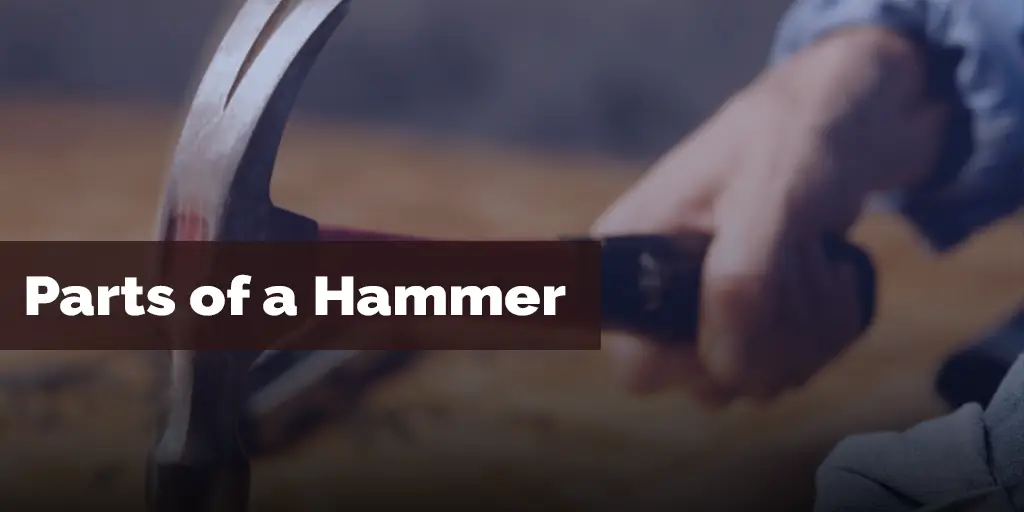From driving small nails into a wooden frame to shaping metal in the hands of skilled blacksmiths, hammers have been indispensable tools for ages.
The simple yet effective design of a hammer, with its head and handle, has stood the test of time.

But when you delve deeper, you realize that not all hammers are the same. Depending on the hammer type, its parts and their functions can vary significantly.
A claw hammer, known for its straight claws, is different from a sledge hammer, which is heavy duty and designed for greater force applied.
Similarly, a ball peen hammer, used mainly by blacksmiths for shaping metals, has a different structure and purpose than a blacksmiths hammer.
The type of hammers available in the market is vast, and each serves a unique purpose, from driving nails to heavy-duty construction tasks.
Moreover, the materials used in making hammers have evolved over time. From the traditional wooden handles that gave a firm grip, to the more modern steel handle and fiberglass handles, which offer durability and reduced vibration.
The hammer head, the striking surface of the tool, is meticulously designed to provide the right balance and force. The handle, which connects the head to the main body, plays a pivotal role in the force and precision of the hammer.
This guide aims to provide an in-depth understanding of the parts of a hammer, their significance, and the myriad types available.
Whether you’re a professional, a DIY enthusiast, or someone simply curious about tools, this comprehensive guide will shed light on the fascinating world of hammers.
What is a Hammer?

A hammer is one of the most fundamental tools known to humanity. Its primary purpose is to deliver force to an object, be it for driving nails, shaping metal, or breaking things apart.
When you break down the anatomy of a hammer, it primarily consists of two parts: the hammer head and the hammer handle.
The hammer head, often made of hard materials like steel, provides the striking surface. This is where the force applied by the user is concentrated and transferred to the object being struck.
The shape and design of the head vary depending on the hammer type, from the flat surface of a claw hammer to the rounded end of a ball peen hammer.
The hammer handle, on the other hand, is the elongated part that the user grips. This part connects the head to the handle, ensuring a secure connection.
Handles can be made from various materials, including wood, steel, or fiberglass. Wooden handles are traditional and provide a comfortable grip, while steel and fiberglass handles offer more durability and can absorb shock better.
Here are some fascinating facts about hammers:
- Driving Nails: While hammers are versatile tools, their most common use is to drive small nails into various materials.
- Blacksmith’s Essential: In the world of blacksmithing, hammers like the blacksmiths hammer and the cross peen are essential for shaping metal and creating intricate designs.
- Evolution: The earliest hammers were merely stones used for pounding. Over time, as human needs evolved, so did the design and type of hammers.
In the subsequent sections, we’ll delve deeper into the individual parts of a hammer, exploring their functions and significance.
We’ll also look at the various types of hammers available, each with its unique features and applications.
An In-depth Look at the Parts of a Hammer
When we hold a hammer, we often think of it as a singular unit. However, each hammer is a culmination of meticulously designed parts that work in harmony.
Let’s dissect the anatomy of a hammer to understand its various components better.
Hammer Head

The hammer head is the business end of the tool. It’s where all the action happens. Depending on the hammer type, the head can have various shapes and designs.
- Striking Surface: This is the flat part of the head that comes in contact with the object being struck. It’s designed to deliver force evenly and effectively. For instance, when driving nails, the force applied needs to be direct and powerful.
- Claw or Peen: On the opposite side of the striking surface, some hammers, like the claw hammer, have a curved claw used for pulling out nails. The ball peen hammer, on the other hand, has a rounded peen used for shaping metal.
- Eye: This is the hole where the handle is attached. It’s crucial for the eye to be perfectly shaped to hold the handle securely. A loose handle can be dangerous, as it can detach from the head during use.
Hammer Handle

The hammer handle is equally vital. It determines the leverage, force, and control a user has over the tool.
- Material: Traditionally, wooden handles were popular due to their comfortable grip and flexibility. However, modern hammers often feature steel or fiberglass handles for added durability and shock absorption. The choice of material can significantly affect the hammer’s weight and balance.
- Grip: The bottom end of the handle, where the user holds the hammer, often has a designed grip. This ensures the tool doesn’t slip from the user’s hand, especially during heavy-duty tasks.
- Length: Depending on the type of hammer, the length of the handle can vary. For instance, sledge hammers have longer handles to provide more force, while tack hammers have shorter handles for precision.
Here’s a simple table to showcase the common materials used for hammer handles and their advantages:
| Material | Advantages |
|---|---|
| Wood | Comfortable grip, traditional look, flexibility |
| Steel | Durability, strength, can handle heavy-duty tasks |
| Fiberglass | Shock absorption, durability, lightweight |
Understanding the parts of a hammer is crucial, not just for professionals but for anyone who uses this tool. It allows users to choose the right hammer for their needs and ensures safety during use.
Different Types of Hammers and Their Unique Features
Hammers come in various shapes and sizes, each tailored for specific tasks. Here, we’ll introduce some of the most common types of hammers, highlighting their distinctive features and primary uses.
Ball Peen Hammer

Often used in metalwork, the ball peen hammer has a flat striking surface and a rounded peen on the opposite side. This design is perfect for shaping metal and riveting.
- Primary Use: Shaping metal, expanding the edge of copper or other soft metals.
- Distinctive Feature: Rounded peen, often used by blacksmiths.
Claw Hammer

The claw hammer is perhaps the most recognized hammer type. Its curved claw is perfect for extracting nails, while its flat head is designed for driving nails.
- Primary Use: Driving nails and removing them using the curved claw.
- Distinctive Feature: Curved claw and flat striking surface.
Sledge Hammer

The sledge hammer is a heavy-duty tool with a large, flat head. Its long handle allows the user to generate significant force, making it ideal for breaking things apart.
- Primary Use: Breaking concrete, stone, or other hard materials.
- Distinctive Feature: Heavy head and long handle.
Tack Hammer

This hammer, with its long and slender design, is perfect for driving small nails or tacks, typically used in upholstery.
- Primary Use: Driving small nails or tacks.
- Distinctive Feature: Lightweight with a magnetized head on one side to start tacks.
Blacksmiths Hammer

The blacksmiths hammer, often used in forging, has a flat end for striking and a chisel-like end for cutting and shaping metal.
- Primary Use: Forging and shaping metal in blacksmithing.
- Distinctive Feature: Flat end and a chisel-like end.
Rubber Mallet

This hammer, with its rubber head, is ideal when you need to apply force without damaging the surface.
- Primary Use: Adjusting tiles or glass without breaking them.
- Distinctive Feature: Soft, rubber head.
And more…
Each type of hammer is designed with a specific task in mind, ensuring efficiency and precision. When choosing a hammer, it’s essential to consider its primary use and the material of both the head and handle.
This ensures you get the right tool for the job, whether it’s driving small nails, shaping metal, or any other task.
Various Applications of Hammers
Hammers, with their diverse range of types and designs, find utility in numerous applications. From daily household chores to specialized industrial tasks, the versatility of hammers is unparalleled.
Here, we’ll highlight some of the common and unique uses of hammers.
Domestic Uses
- Home Repairs and Maintenance: From hanging pictures to fixing a squeaky floorboard, hammers are essential for various DIY tasks around the house.
- Crafts and Hobbies: Be it woodworking, leathercraft, or jewelry making, hammers play a pivotal role in shaping, fixing, and creating.
- Gardening: Whether it’s for securing fence posts or breaking hard soil, a hammer often comes in handy in the garden.
Industrial Applications
- Construction: Hammers are indispensable on construction sites. From framing walls with the help of a framing hammer to breaking down materials with a sledgehammer, their utility is vast.
- Metalwork: In the world of metal shaping and forging, specialized hammers like the ball peen hammer and blacksmiths hammer are crucial.
- Carpentry: For tasks like driving nails into wood or extracting them, the claw hammer is a carpenter’s best friend.
Artistic Purposes
- Sculpture: Artists working with stone or metal often use hammers to shape their creations meticulously.
- Jewelry Making: Precision hammers help jewelers craft intricate designs, especially when working with delicate materials.
Specialized Tasks
- Upholstery: The tack hammer, with its magnetized head, is perfect for driving small nails or tacks, ensuring fabric is held in place.
- Masonry: Masons rely on hammers to shape and fit stones, ensuring stable and aesthetically pleasing structures.
- Automotive Repair: Whether it’s bodywork or fixing components, hammers find utility in various automotive repair tasks.
Hammers, with their myriad types and designs, have carved a niche for themselves in almost every domain.
Their applications underscore the tool’s importance and versatility, proving why it has remained relevant for millennia.
You May Also Enjoy Reading: The Best Felling Axe
Frequently Asked Questions about Hammer Parts
Hammers, despite being everyday tools, are surrounded by numerous queries. Here, we address some of the most common questions related to the parts of a hammer.
What are the parts of a hand hammer called?
A hand hammer primarily consists of two main parts: the hammer head and the hammer handle.
The head can further be broken down into the striking surface and, depending on the type of hammer, a claw or peen. The handle might also have a specific grip design at its bottom for better handling.
What is the side of the hammer called?
The side opposite the striking surface can vary based on the type of hammer. For a claw hammer, it’s called the claw. For a ball peen hammer, it’s referred to as the ball peen or simply peen.
What is the part of a tool hammer?
The primary parts of a tool hammer are the head and the handle. The head delivers the force to the target, while the handle allows the user to grip and control the hammer.
What are the three 3 types of hammers?
There are numerous types of hammers, but three common ones are the claw hammer (used mainly for driving and pulling out nails), the ball peen hammer (used in metalwork), and the sledge hammer (a heavy-duty hammer used for breaking hard materials).
What are the parts of the hammer and their functions?
The hammer head provides the striking force. Depending on the type, the other side of the head can be used for various tasks, such as pulling out nails (in the case of a claw hammer) or shaping metal (for a ball peen hammer).
The handle allows the user to grip the hammer, providing leverage and control.
Safety Precautions when Using Hammers
The importance of safety cannot be overstated, especially when working with tools like hammers. A momentary lapse in attention can lead to injuries. Here are some safety guidelines to ensure safe and efficient use of hammers:
Check the Hammer Before Use
Before starting any task, inspect the hammer thoroughly. Ensure that the hammer head is securely attached to the handle. A loose head can fly off during use, posing a significant risk.
Use the Right Hammer for the Job
Always select a hammer that is suited for the task at hand. Using a sledgehammer for a job meant for a tack hammer isn’t just inefficient; it’s dangerous.
Wear Protective Gear
Always wear safety glasses to protect your eyes from flying debris. If you’re working in a noisy environment, consider using ear protection.
Grip the Hammer Properly
Hold the hammer at the end of the handle to get the maximum force and control. A grip closer to the head provides less force and can lead to inaccurate strikes.
Strike Properly
Ensure that the striking surface of the hammer head is flat against the target. Hitting with the edge can lead to chipping.
Store Properly
After use, store the hammer in a safe place, away from the reach of children. Ideally, hang it by its handle or place it in a toolbox.
Replace Damaged Hammers
If the handle is cracked or the head is loose, it’s time to replace the hammer. Using a damaged hammer can be extremely hazardous.
Be Aware of Your Surroundings
Before swinging the hammer, ensure that no one is standing close by. It’s easy to lose control, especially if you’re applying a lot of force.
Remember: A hammer, like all tools, is as safe as the person using it. Always prioritize safety, and if you’re unsure about the right hammer or technique for a job, seek expert advice.
Conclusion
Hammers, with their age-old design and varied applications, remain one of the most essential tools in human history.
From the early days of simple stones to the intricately designed modern variants, the journey of hammers is a testament to human ingenuity and adaptation.
Whether you’re driving nails, shaping metal, or undertaking heavy-duty construction tasks, there’s a hammer designed specifically for the job.
By understanding the parts of a hammer, its types, and its applications, one can ensure efficient and safe use. Remember, like all tools, a hammer is an extension of the hand. Use it wisely, safely, and responsibly.



